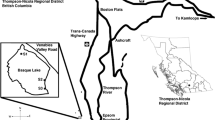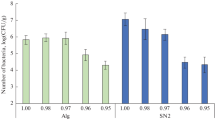Abstract
Bacterial cell numbers obtained from 103 water and sediment samples from a Pleistocene sandy aquifer in the Lower Rhine region (Bocholt, FRG) were determinated on P-agar and by direct count. Below 5 m under the surface, colony-forming unit (cfu) numbers in water samples were less than 100/ml, and in many cases less than 50/ml. In sediment samples, they were 10- to 100-fold higher (102−104 cfu/g dry wt), but changing markedly between different depths. Direct cell counts yielded numbers two to three orders of magnitude higher.
About 2,700 strains of bacteria from 60 samples were isolated randomly and characterized by morphological and physiological properties. Of all the isolates, 71.6% were gram-negative, and 52.2% were gram-negative straight rods. Water communities, with one exception, had low proportions of gram-positive bacteria (<11%), whereas in all but one of the sediment communities percentages of gram-positive isolates were three- to sevenfold higher (35–43%). Water and sediment communities, as well as communities from different sampling sites and communities from different depths of the same sampling site, differed in their qualitative and quantitative morphotype composition and physiological capabilities.
The in vitro activities of strains within a single community were quite different, indicating that each community is composed of many diverse bacteria, several having extremely different capabilities. Thus, each community has its own specific activity pattern. Gram-positive bacteria showed on an average lower total activities than did gram-negative bacteria. Grampositive bacteria as well as gram-negative bacteria from sediment had higher values of in vitro activities than the corresponding groups isolated from water. Many water and sediment bacteria preferred the same substrates which were utilized at high rates. However, there were differences in the degradation of the various other substrates present, and each community showed preferences for particular substrates, which they degraded best.
The results of cell morphology and physiology studies indicated that all eight characterized communities were very different from one another and very diversely structured.
Similar content being viewed by others
References
Balkwill DL, Ghiorse WC (1985) Characterization of subsurface bacteria associated with two shallow aquifers in Oklahoma. Appl Environ Microbiol 50:580–588
Buchanan-Mappin JM, Wallis PM, Buchanan AG (1986) Enumeration and identification of heterotrophic bacteria in groundwater and in a mountain stream. Can J Microbiol 32:93–98
Dott W, Trampisch HJ (1983) Qualitative und quantitative Bestimmung von Bakterienpopulationen aus aquatischen Biotopen. 5. Mitteilung: Vergleichende Untersuchungen an zwei Schncllsandfiltern. Zbl Bakt Hyg, I Abt Orig B 177:141–155.
Ghiorse WC, Balkwill DL (1983) Enumeration and morphological characterization of bacteria indigenous to subsurface environments. Dev Ind Microbiol 24:213–224
Hack A, Leuchs, W, Obermann P (1984) Der Salzsprung im Grundwasser. Geowiss uns Zeit 6:194–200
Hirsch P, Rades-Rohkohl E (1983) Microbial diversity in a groundwater aquifer in northern Germany. Dev Ind Microbiol 24:183–199
Hoos E, Schweisfurth R (1982) Untersuchungen über die Verteilung von Bakterien von 10 bis 90 Meter unter Bodenoberkante. Vom Wasser 58:103–112
Kölbel-Boelke J, Tienken B, Nehrkorn A (1988) Microbial communities in the saturated groundwater environment. I. Methods of isolation and characterization of heterotrophic bacteria. Microb Ecol 16:17–29
Leuchs W (1985) Mikrobiell beeinfluβte Stoffverschiebungen zwischen Grundwasser und Grundwasserleiter in einem pleistozänen Aquifer. Z dt geol Ges 136:553–561
Marxsen J (1981) Bacterial biomass and bacterial uptake of glucose in polluted and unpolluted groundwater of sandy and gravelly deposits. Verh Internat Verein Limnol 21:1371–1375
Olson GJ, Dockins WS, McFeters GA, Iverson WP (1981) Sulphate-reducing and methanogenic bacteria from deep aquifers in Montana. Geomicrobiol J 2:327–340
Stetzenbach LD, Kelley LM, Sinclair NA (1986) Isolation, identification, and growth of well water bacteria. Ground Water 24:6–10
White DC, Smith GA, Gehron MJ, Parker JH, Findlay RH, Martz RF, Fredrickson HL (1983) The groundwater aquifer microbiota: biomass, community structure, and nutritional status. Dev Ind Microbiol 24:189–199
Wilson JT, McNabb JF, Balkwill DL, Ghiorse WC (1983) Enumeration and characterization of bacteria indigenous to a shallow water-table aquifer. Ground Water 21:134–142
Wolters N, Schwartz W (1956) Untersuchungen über Vorkommen und Verhalten von Mikroorganismen in reinen Grundwässern. Arch Hydrobiol 51:500–541
Author information
Authors and Affiliations
Rights and permissions
About this article
Cite this article
Kölbel-Boelke, J., Anders, E.M. & Nehrkorn, A. Microbial communities in the saturated groundwater environment II: Diversity of bacterial communities in a Pleistocene sand aquifer and their in vitro activities. Microb Ecol 16, 31–48 (1988). https://doi.org/10.1007/BF02097403
Issue Date:
DOI: https://doi.org/10.1007/BF02097403




